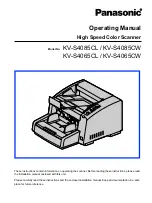
Page 5
Poll
O/79
0 - RS232
1 - TCP
2 – CAN
Request a single data packet (in the current active format) for
the channel selected. Data streaming should be set off before
using this command. Note that there is no positive
acknowledge for this command. This command is not valid for
logging to Internal RAM.
Span
A/65
None
Request a ‘span’ operation. The unit should have been recently
rezeroed, then the appropriate span pressure (as selected from
the setup software) applied to the scanner. Requesting a span
operation will then calculate the span correction coefficient for
each channel. All rezero values and span coefficients are then
written to the unit’s EEPROM (NOT to the scanner), and the
calibration tables rebuilt using these new values.
Reset Linear
Calibration
E/69
None
Resets the linear calibration (ie zero and span values) held
within the unit to 0 and 1.0 respectively for all channels. A
calibration table rebuild is then performed.
Hardware
Trigger
T/84
byte = 0xab
a = 0 Disable
a = 1 Enable
b = 0 RS232
b = 1 TCP
b = 2 CAN
b = 3 Internal RAM
b = 4 Internal RAM
(stop on full)
Enables or disables the hardware trigger on the selected
channel. Note that there is no positive acknowledge for this
command.
Assuming a valid hardware trigger is detected for the duration,
Internal RAM data streaming will either log continuously,
wrapping (and therefore overwriting) when the end of available
RAM is reached, or will stop when the RAM is full (and
automatically disable the hardware trigger), depending on the
parameter.
Start Internal
RAM Dump
I/73
0 - RS232
1 - TCP
2 - CAN
Starts the internal RAM dump, sending data using the comms
channel chosen by the parameter. The first packet is sent
immediately and consists of a 9 byte header (only 6 bytes for
CAN - see later)
Internal RAM
Dump
Handshake
J/74
None
Handshake command to indicate previous packet was received.
Must be sent after header packet & all subsequent data
packets.
Figure 2.2, The Available User Command Set for the microDAQ.



































